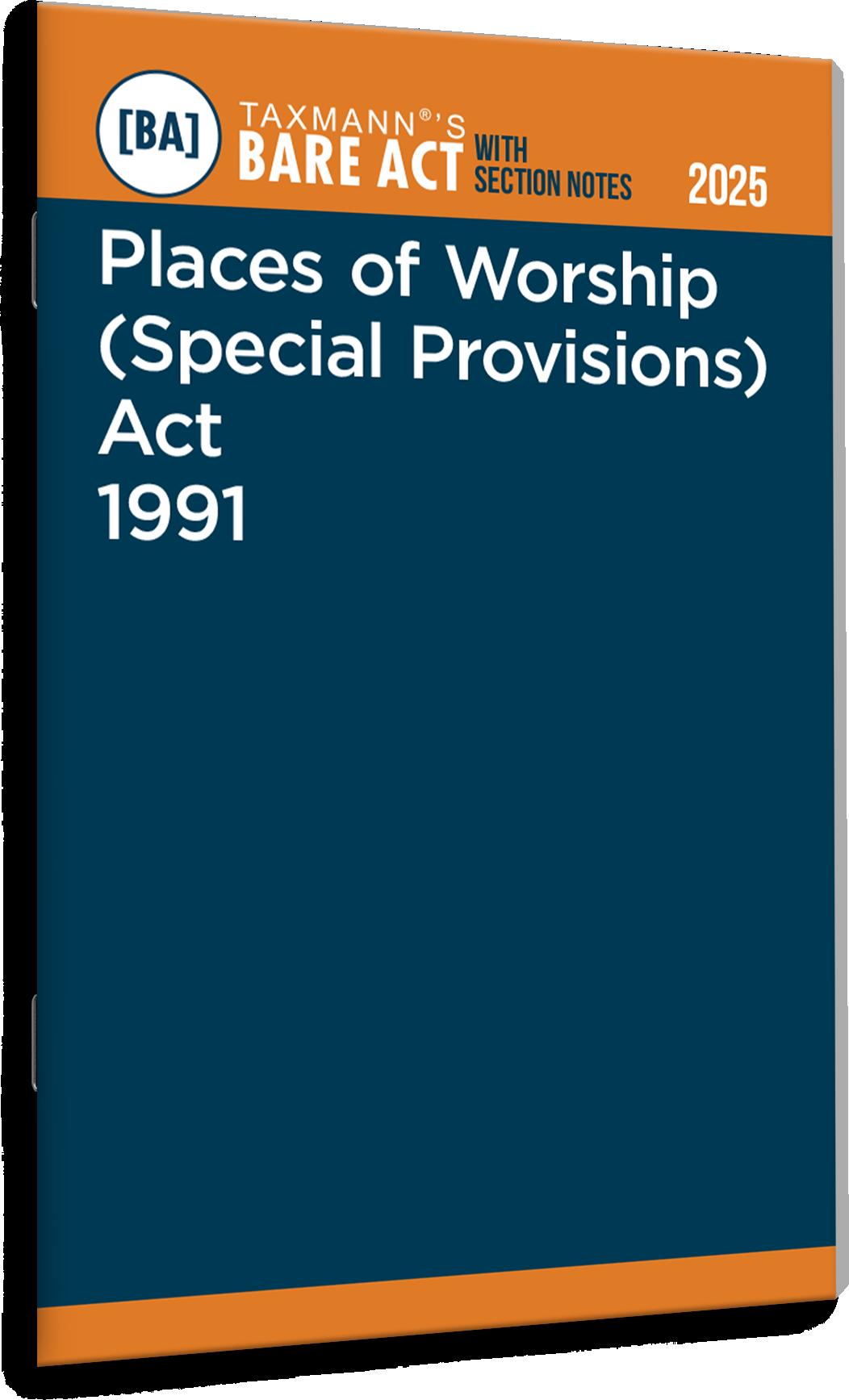© Taxmann Price : ` 65
Published by :
Taxmann Publications (P.) Ltd.
Sales & Marketing : 59/32, New Rohtak Road, New Delhi-110 005 India
Phone : +91-11-45562222
Website : www.taxmann.com
E-mail : sales@taxmann.com
Regd. Office :
21/35, West Punjabi Bagh, New Delhi-110 026 India
Printed at :
Tan Prints (India) Pvt. Ltd.
44 Km. Mile Stone, National Highway, Rohtak Road Village Rohad, Distt. Jhajjar (Haryana) India
E-mail : sales@tanprints.com
Disclaimer
Every effort has been made to avoid errors or omissions in this publication. In spite of this, errors may creep in. Any mistake, error or discrepancy noted may be brought to our notice which shall be taken care of in the next edition. It is notified that neither the publisher nor the author or seller will be responsible for any damage or loss of action to any one, of any kind, in any manner, therefrom. It is suggested that to avoid any doubt the reader should cross-check all the facts, law and contents of the publication with original Government publication or notifications.
No part of this book may be reproduced or copied in any form or by any means [graphic, electronic or mechanical, including photocopying, recording, taping, or information retrieval systems] or reproduced on any disc, tape, perforated media or other information storage device, etc., without the written permission of the publishers. Breach of this condition is liable for legal action. For binding mistake, misprints or for missing pages, etc., the publisher’s liability is limited to replacement within seven days of purchase by similar edition. All expenses in this connection are to be borne by the purchaser. All disputes are subject to Delhi jurisdiction only.
PLACES OF WORSHIP (SPECIAL PROVISIONS) ACT, 1991
1. Short title, extent and commencement 1 2. De nitions 2
3. Bar of conversion of places of worship 2
4. Declaration as to the religious character of certain places of worship and bar of jurisdiction of courts, etc. 4
5. Act not to apply to Ram Janma Bhumi - Babri Masjid 5
6. Punishment for contravention of section 3 5
7. Act to override other enactments 6
8. [Repealed by the Repealing and Amending Act, 2001, w.e.f. 3-9-2001] 6
INDEX
Places of Worship (Special Provisions) Act, 1991
[42 OF 1991*]
An Act to prohibit conversion of any place of worship and to provide for the maintenance of the religious character of any place of worship as it existed on the 15th day of August, 1947, and for matters connected therewith or incidental thereto.
BE it enacted by Parliament in the Forty-second Year of the Republic of India as follows:—
Short title, extent and commencement.
1. (1) This Act may be called the Places of Worship (Special Provisions) Act, 1991.
(2) It extends to the whole of India except the State of Jammu and Kashmir1
(3) The provisions of sections 3, 6 and 8 shall come into force at once and the remaining provisions of this Act shall be deemed to have come into force on the 11th day of July, 1991.
COMMENTS
SECTION NOTES
1.1 The act applies to the whole of India
It extends to the whole of India. [Section 1(2)]
The Jammu and Kashmir Reorganisation (Removal of Difficulties) Order, 2019, made this Act applicable to the Union territories of Jammu and Kashmir and Ladakh.
1.2 Act not to apply to Ram Janma Bhumi - Babri Masjid.
Nothing contained in this Act shall apply to the place or place of worship commonly known Ram Janma Bhumi - Babri Masjid situated in Ayodhya in the State of Uttar Pradesh and to any suit, appeal or other proceeding relating to the said place or place of worship. [Section 5 of this Act]
*Dated 18-9-1991.
1. This Act is made applicable to the Union territory of Jammu and Kashmir and the Union territory of Ladakh by the Jammu and Kashmir Reorganisation (Removal of Difficulties) Order, 2019, w.e.f. 30-10-2019.
S. 3 PLACES OF WORSHIP (SPECIAL PROVISIONS) ACT, 1991 2
1.3 Non-applicability to any place of worship which is an ancient and historical monument or archaeological site
See Section 4(3)(a) of this Act.
De nitions.
2. In this Act, unless the context otherwise requires,—
(a) “commencement of this Act” means the commencement of this Act on the 11th day of July, 1991;
(b) “conversion”, with its grammatical variations, includes alteration or change of whatever nature;
(c) “place of worship” means a temple, mosque, gurudwara, church, monastery or any other place of public religious worship of any religious denomination or any section thereof, by whatever name called.
Bar of conversion of places of worship.
3. No person shall convert any place of worship of any religious denomination or any section thereof into a place of worship of a different section of the same religious denomination or of a different religious denomination or any other section thereof.
COMMENTS
SECTION NOTES
The provisions of this Section are to be read in the light of Sections 4(1), 4(3)(a) and 5 of this Act.
The religious character of a place of worship existing on the 15th day of August, 1947 shall continue to be the same as it existed on that day. [Section 4(1) of this Act]
The bar placed by section 3 is on conversion of any place of worship of any religious denomination or section thereof into a place of worship of a different religious denomination or section thereof. There is no bar on conversion of a place of worship for non-religious/secular use.
No person shall convert any place of worship of any religious denomination or any section thereof as existing on 15-08-1947 into a place of worship of a different section of the same religious denomination or of a different religious denomination or any other section thereof. [Section 3]
The above provisions are not applicable to the place or place of worship commonly known Ram Janma Bhumi - Babri Masjid situated in Ayodhya in the State of Uttar Pradesh and to any suit, appeal or other proceeding relating to the said place or place of worship. [Section 5 of this Act]
The above provisions of section 3/4(1)(a) are not applicable to any place of worship which is an ancient and historical monument or archaeological site or remains covered under the Archaeological Monuments and Archaeological Sites and Remains Act, 1958 [See Section 4(3)(a)]
Contravention of Section 3 is a punishable offence - See Section 6 of this Act.
CASE LAWS
Conversion of Place of Worship - Secular Use Exception - The case concerned the petitioners’ request to use All Saints Church, located within the Viceregal Lodge Estate in Shimla, for religious worship. The petitioners claimed that under Section 3 of the Places of Worship Act, 1991, the conversion of a place of worship was prohibited, and thus the church must continue to function as a religious site. The Himachal Pradesh High Court held that Section 3 bars the conversion of a place of worship from one religion or sect to another but does not apply when the conversion is for a secular or non-religious purpose. Since the church was part of a declared ancient monument under the Ancient Monuments and Archaeological Sites and Remains Act, the provisions of the Places of Worship Act did not apply, and the church could be maintained as part of the historical estate without regular religious services. The Court dismissed the petition, noting that the government had no intention of altering the religious character but was merely restoring the structure as part of the heritage site. – Satinder Kumar v. Union of India AIR 2007 Himachal Pradesh 77.
Acquisition of Religious Property - Application of Places of Worship Act - The case involved the Surat Municipal Corporation’s decision to widen a road, necessitating the demolition of parts of two mosques, Minarawali Masjid and Golwali Masjid. The petitioners argued that the Places of Worship (Special Provisions) Act, 1991, prohibited such actions as it would alter the status of these religious sites. The Gujarat High Court held that Section 3 of the Act bars the conversion of a place of worship but does not prevent the State from acquiring any place of worship or part thereof for a public purpose, such as road widening. The Court emphasized that acquisition for public purposes like traffic management does not violate the Act’s provisions, as long as the action does not alter the essential character of the place as a religious site. The petitions challenging the orders for demolition were partly allowed, protecting certain parts of the prayer halls while permitting acquisition of other portions. – Gulam Kadar Ahmadbhai Menon v. Surat Municipal Corporation AIR 1998 Gujarat 234.
Acquisition for Public Purpose - Religious Property - The case involved the acquisition of land for the expansion of a National Highway, which included a church and adjacent graveyard. The petitioners argued that Section 3 of the Places of Worship Act, 1991, prohibits the conversion or acquisition of religious properties, and the proposed demolition infringed their religious rights under Articles 25 and 26 of the Constitution. The Allahabad High Court held that Section 3 aims to prevent the conversion of a place of worship from one religion or sect to another but does not restrict acquisition for public purposes under statutory land acquisition laws. The Court ruled that public interest in infrastructure development justi ed the acquisition, provided fair compensation. The petition was dismissed, with a temporary stay on demolition for one month to allow for negotiations. – Church of North India Trust Association v. Union of India AIR 2017 Allahabad 143.
Vesting of Religious Properties - Applicability of Places of Worship Act - The dispute in this case involved the vesting of Parasnath Hill under the Bihar Land Reforms Act, 1950. The Swetambar Jain community contended that the entire hill, being a place of worship, should not be subject to vesting by the State under the Land Reforms Act due to its religious significance. The appellants argued that, as per Section 3 of the Places of Worship (Special Provisions) Act, 1991, any attempt to alter the character of the place of worship as it existed on 15th August 1947 is prohibited. However, the court held that the Places of Worship Act does not apply to the vesting of the hill under the Bihar Land Reforms Act, as the vesting was for land reforms and the act’s provisions cannot be invoked merely based on the community’s belief. The religious status of the area is limited to specific portions like temples and shrines, not the entire hill. – Seth Srenikbhai Kasturbhai v. Seth Chandulal Kasturchand AIR 1997 Patna 179.
Bare Act with Section Notes
AUTHOR : TAXMANN'S EDITORIAL BOARD
PUBLISHER : TAXMANN
DATE OF PUBLICATION : JANUARY 2025
EDITION : 2025 EDITION
ISBN NO : 9789364551878
NO. OF PAGES : 16
BINDING TYPE : PAPERBACK
DESCRIPTION
Places of Worship (Special Provisions) Act [Bare Act with Section Notes] by Taxmann combines the statutory provisions, section notes, and case law references in one volume. It is an authoritative resource for anyone seeking clarity on preserving religious sites in India.
This book is intended for the following audience:
• Legal Practitioners & Litigators
• Judicial Officers & Academicians
• Government Officials & Policymakers
• Students & Aspirants
• General Public & NGOs
The Present Publication is the 2025 Edition, covering the amended and updated text of the Places of Worship (Special Provisions) Act [Act No. 42 of 1991], with the following noteworthy features:
• [Bare Act Text (As Amended)] Reflects all current amendments, including the Repealing and Amending Act, 2001
• [Section Notes] Explains the intent, scope, and application of each provision, supported by judicial decisions
• [Exhaustive Case Law References] Includes pertinent citations from the Supreme Court and High Courts
• [Pre-amendment Provisions] Shows how the law existed prior to specific amendments, highlighting historical applicability
• [User-friendly Formatting] Employs clear headings, indentation, and bold text for quick reference
• [Subject Index] Facilitates easy location of provisions, case studies, or key terms







